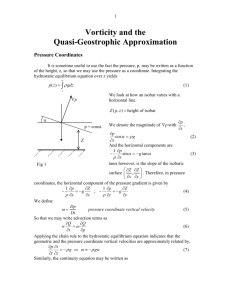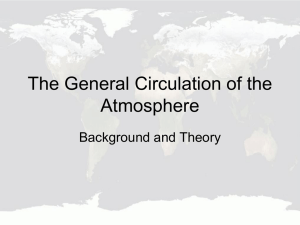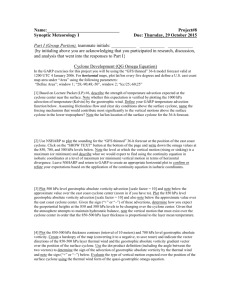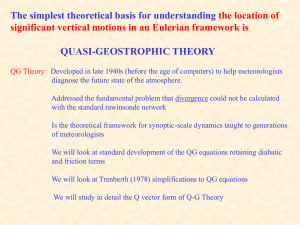The Quasi-Geostrophic Height Tendency Equation
advertisement
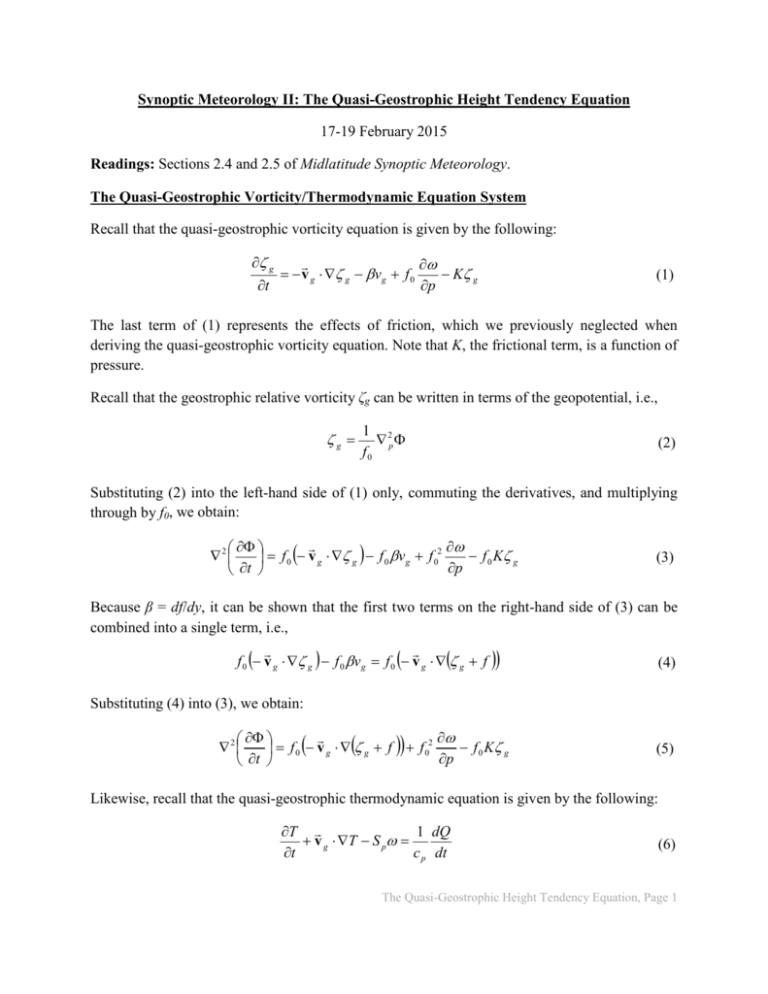
Synoptic Meteorology II: The Quasi-Geostrophic Height Tendency Equation 17-19 February 2015 Readings: Sections 2.4 and 2.5 of Midlatitude Synoptic Meteorology. The Quasi-Geostrophic Vorticity/Thermodynamic Equation System Recall that the quasi-geostrophic vorticity equation is given by the following: ∂ζ g ∂ω = − v g ⋅ ∇ζ g − β v g + f 0 − Kζ g ∂t ∂p (1) The last term of (1) represents the effects of friction, which we previously neglected when deriving the quasi-geostrophic vorticity equation. Note that K, the frictional term, is a function of pressure. Recall that the geostrophic relative vorticity ζg can be written in terms of the geopotential, i.e., ζg = 1 2 ∇ pΦ f0 (2) Substituting (2) into the left-hand side of (1) only, commuting the derivatives, and multiplying through by f0, we obtain: ∂Φ 2 ∂ω ∇2 − f 0 Kζ g = f 0 (− v g ⋅ ∇ζ g ) − f 0 βv g + f 0 ∂p ∂t (3) Because β = df/dy, it can be shown that the first two terms on the right-hand side of (3) can be combined into a single term, i.e., f 0 (− v g ⋅ ∇ζ g ) − f 0 βv g = f 0 (− v g ⋅ ∇(ζ g + f )) (4) Substituting (4) into (3), we obtain: ∂Φ 2 ∂ω ∇2 − f 0 Kζ g = f 0 (− v g ⋅ ∇(ζ g + f )) + f 0 ∂p ∂t (5) Likewise, recall that the quasi-geostrophic thermodynamic equation is given by the following: ∂T 1 dQ + v g ⋅ ∇T − S p ω = ∂t c p dt (6) The Quasi-Geostrophic Height Tendency Equation, Page 1 In (6), Sp is the static stability and is equal to σp/R. We desire to rewrite (6) in terms of potential temperature rather than temperature. To do so, we make use of Poisson’s relationship, R p cp θ = T 0 p (7) It can be shown that a function h can be defined as: cv R p0 c p h( p ) = p0 p (8) Plugging (7) and (8) into (6), the quasi-geostrophic thermodynamic equation becomes: ∂ (hθ ) R dQ + v g ⋅ ∇(hθ ) − σω = ∂t pc p dt (9) where σ = −h dθ 0 dp (10) Likewise, plugging (7) and (8) into the hydrostatic relationship, we obtain: ∂Φ = −hθ ∂p (11) If we plug (11) into the left-hand side of (9) and commute the derivatives, we obtain: − ∂ ∂Φ R dQ + v g ⋅ ∇(hθ ) − σω = ∂p ∂t pc p dt (12) Rearranging (12) to leave only the term involving Φ on the left-hand side, we obtain: − ∂ ∂Φ R dQ = − v g ⋅ ∇(hθ ) + σω + ∂p ∂t pc p dt (13) The quasi-geostrophic vorticity (5) and thermodynamic (13) equations represent two equations containing two unknowns – vertical motion ω and geopotential height Φ – or variables such as The Quasi-Geostrophic Height Tendency Equation, Page 2 the geostrophic relative vorticity ζg and potential temperature θ that can be obtained from knowledge of the geopotential height field. To obtain the quasi-geostrophic height tendency equation, we wish to combine these two equations in a way that eliminates ω between the two equations, leaving a single equation for Φ that describes how the geopotential field on an isobaric surface evolves with time. We will follow a similar procedure when obtaining the quasi-geostrophic omega equation in the next lecture, except eliminating Φ between the two equations to leave a single equation for ω. The Quasi-Geostrophic Height Tendency Equation To obtain the quasi-geostrophic height tendency equation, equations (5) and (13) are combined. ∂ 1 To do so, we first take − f 02 of the quasi-geostrophic thermodynamic equation (13): ∂p σ f 02 f 02 R ∂ 1 dQ ∂ 1 ∂ ∂Φ 2 ∂ h 2 ∂ω ( ) = − f f − ⋅ ∇ − − θ v 0 g 0 ∂p ∂p σ ∂p ∂t c p ∂p σp dt ∂p σ (14) If we then add (5) and (14), the terms involving ∂ω/∂p cancel out, leaving only one equation for the time tendency of the geopotential height field. Doing so, we obtain the quasi-geostrophic height tendency equation, as given by: ∇2 ∂ 1 ∂ ∂Φ ∂Φ 2 ∂ h (− v g ⋅ ∇θ ) + f 02 = f 0 (− v g ⋅ ∇(ζ g + f )) − f 0 ∂t ∂p σ ∂p ∂t ∂p σ f 2 R ∂ 1 dQ − f 0 Kζ g − 0 c p ∂p σp dt (15) Equation (15) is a partial differential equation describing the local change of the geopotential height Φ on an isobaric surface with respect to time. There are four forcing terms on the righthand side of Equation (15). From left to right, these forcing terms represent geostrophic vorticity advection, differential potential temperature advection, friction, and differential diabatic heating. Note that this equation is applied to the study of troughs and ridges in the middle troposphere – often at 500 hPa – and not at the surface. In later lectures, we will discuss appropriate frameworks for studying the evolution of surface cyclones and anticyclones. If we make the substitution that χ = ∂Φ/∂t, then (15) becomes: The Quasi-Geostrophic Height Tendency Equation, Page 3 ∇ 2 c + f 02 ∂ 1 ∂c ∂ h ( = f 0 (− v g ⋅ ∇(ζ g + f )) − f 02 − v g ⋅ ∇θ ) ∂p σ ∂p ∂p σ f 2 R ∂ 1 dQ − f 0 Kζ g − 0 c p ∂p σp dt (16) The left-hand side of (16) expresses χ in terms of the Laplacian ( ∇ 2 ) as well as a second derivative with respect to pressure. Based upon the definitions of these operators, the left-hand side of (16) can be approximated as: ∇ 2 χ + f 02 ∂ 1 ∂χ ∝ −χ ∂p σ ∂p (17) The ∝ symbol means “is proportional to,” such that the left-hand side of (16) is proportional to –χ. Therefore, where the right-hand side of (16) is positive, χ is negative, implying a local decrease in the geopotential height with time on a given isobaric surface. Likewise, where the right-hand side of (16) is negative, χ is positive, implying a local increase in the geopotential height with time on a given isobaric surface. Interpretation of the Quasi-Geostrophic Height Tendency Equation We now wish to interpret the contributions to the local geopotential height tendency from each of the four forcing terms on the right-hand side of (16). Geostrophic Vorticity Advection The contribution to the local geopotential height tendency exclusively due to geostrophic vorticity advection can be expressed by: χ ∝ − f 0 (− v g ⋅ ∇(ζ g + f )) (18) The term inside of the outermost set of parentheses is an advection term. It depicts the advection by the geostrophic wind of the geostrophic relative (ζg) and planetary (f) vorticity. Cyclonic geostrophic vorticity advection is defined by − v g ⋅ ∇(ζ g + f ) > 0 . Because f0 is positive-definite in the Northern Hemisphere, cyclonic geostrophic vorticity advection on an isobaric surface will result in χ < 0, implying a local decrease in geopotential height with time. Likewise, anticyclonic geostrophic vorticity advection is defined by − v g ⋅ ∇(ζ g + f ) < 0 . Thus, anticyclonic geostrophic vorticity advection on an isobaric surface will result in χ > 0, implying a local increase in geopotential height with time. The Quasi-Geostrophic Height Tendency Equation, Page 4 In the idealized trough/ridge scenario depicted in Figure 1, the geostrophic wind is uniform everywhere and thus geostrophic relative vorticity is maximized (minimized) in the base (apex) of each trough (ridge). Since the geostrophic wind blows parallel to contours of constant geopotential height, geostrophic absolute vorticity advection does not result in the amplification (or intensification) of troughs and ridges. Rather, it results in their movement from one location to another. This is identical to the interpretation offered with the quasi-geostrophic vorticity equation. Figure 1. Conceptual view of the movement of middle-tropospheric ridges and troughs from the perspective of the geostrophic vorticity advection forcing term to the quasi-geostrophic height tendency equation. However, in the real world, the geopotential height field – and thus both geostrophic wind and geostrophic relative vorticity – are rarely as clean as in the idealized example above. Section 2.4 of the Lackmann text, in particular Figs. 2.13 through 2.15 (pgs. 51-53), illustrate two examples in which the geostrophic vorticity advection term can result in the amplification or deamplification of troughs and ridges. In both, isohypse packing – and thus the magnitude of the geostrophic wind is not uniform – between the upstream and downstream sides of a trough (or ridge). In the case of an upstream jet, geostrophic advection of cyclonic shear vorticity into the base of the trough results in its amplification (or digging). In the case of a downstream jet, geostrophic advection of cyclonic shear vorticity out of the base of the trough results in its deamplification (or lifting). As noted in the text, however, other effects can be and often are important, and in general the geostrophic vorticity advection term is chiefly responsible for trough and ridge motion rather than amplification. Differential Potential Temperature Advection The contribution to the local geopotential height tendency exclusively due to differential potential temperature advection can be expressed by: The Quasi-Geostrophic Height Tendency Equation, Page 5 χ ∝ f 02 ∂ h (− v g ⋅ ∇θ ) ∂p σ (19) The term inside the parentheses in (19) is simply the geostrophic advection of potential temperature. However, it is encapsulated within a partial derivative with respect to pressure – a vertical derivative – thus giving rise to the name “differential potential temperature advection.” As a result, the local geopotential height tendency on the isobaric level upon which the quasigeostrophic height tendency equation is applied depends upon the vertical structure of the geostrophic advection of potential temperature. Before proceeding, note that warm potential temperature advection is defined where − v g ⋅ ∇θ > 0 . Conversely, cold potential temperature advection is defined where − v g ⋅ ∇θ < 0 . In the absence of friction and diabatic heating, this term must be non-zero for the amplitude (or intensity) of a middle tropospheric trough or ridge to change. If the quasi-geostrophic height tendency equation is being applied on a middle tropospheric isobaric surface (e.g., 500 hPa), we wish to evaluate potential temperature advection on an isobaric surface below this level (e.g., 700 hPa or 850 hPa) and on an isobaric surface above this level (e.g., 250 hPa or 300 hPa). We first consider the case where potential temperature advection is becoming more positive with increasing height. This corresponds to where (a) warm advection increases with increasing height or (b) cold advection decreases with increasing height. The change in potential temperature advection with height is thus positive. The denominator, the change in pressure with height, is negative – as it always is, since we are subtracting a smaller number (e.g., 300 hPa) from a larger number (e.g., 850 hPa). From (19), this implies χ < 0, signifying a local decrease in the geopotential height in time on the isobaric surface on which the equation is applied. Likewise, consider the case where potential temperature advection is becoming more negative with increasing height. This corresponds to where (c) warm advection decreases with increasing height or (d) cold advection increases with increasing height. The change in potential temperature advection with height is thus negative. The denominator, the change in pressure with height, is again negative. From (19), this implies χ > 0, signifying a local increase in the geopotential height in time on the isobaric surface on which the equation is applied. This term can also be interpreted utilizing thickness arguments, where we recall that the thickness of a vertical layer is directly proportional to the temperature of that layer. Consider first the case where warm potential temperature advection decreases with increasing height. In this case, warm advection is strongest below the isobaric surface upon which we evaluate the height tendency. The greatest increase in thickness due to this vertical structure of warm potential temperature advection is thus in the layer below the isobaric surface upon which we evaluate the The Quasi-Geostrophic Height Tendency Equation, Page 6 height tendency. Increasing the thickness of this layer forces the isobaric surface on which the height tendency is evaluated upward to a higher altitude. This results in a local increase in geopotential height on this isobaric surface with time, in agreement with our previous interpretation. Stated differently, lower tropospheric warm potential temperature advection generally results in increasing middle tropospheric geopotential heights with time. Conversely, consider the case where cold potential temperature advection decreases with increasing height. In this case, cold advection is maximized below the isobaric surface upon which we evaluate the height tendency. The greatest decrease in thickness due to this structure of cold potential temperature advection is below the isobaric surface upon which we evaluate the height tendency. Decreasing the thickness of this layer forces the isobaric level on which the height tendency is evaluated downward to a lower altitude. This results in a local decrease in geopotential height on this isobaric surface with time, in agreement with our previous interpretation. Stated differently, lower tropospheric cold potential temperature advection generally results in decreasing middle tropospheric geopotential heights with time. The thickness-based interpretation of the differential potential temperature advection term, focusing upon the two examples above, is depicted graphically in Figure 2 below. Figure 2. Idealized schematic of the thickness-based interpretation of the effects of (left) warm potential temperature advection (or WAA) decreasing with increasing height and (right) cold potential temperature advection (or CAA) decreasing with increasing height upon height tendency evaluated on the 500 hPa isobaric surface. The black arrows indicate the influence of potential temperature advection upon the local thickness, with larger arrows denoting a larger effect, arrows pointing away from each other indicating increasing thickness, and arrows pointing toward each other indicating decreasing thickness. At left, the elevation of the 500 hPa surface from increased thickness below is greater than the depression of the 500 hPa surface from increased thickness above, and thus the height tendency is positive. At right, the depression of the 500 hPa surface from decreased thickness below is greater than the elevation of the 500 hPa surface from decreased thickness above, and thus the height tendency is negative. The Quasi-Geostrophic Height Tendency Equation, Page 7 Friction The contribution to the local geopotential height tendency exclusively due to friction can be expressed by: χ ∝ f 0 Kζ g (20) In (20), K represents the effects of friction and is positive-definite. K is non-zero only within the boundary layer, close to the surface, where the frictional effects of the land-surface can be meaningfully communicated to the troposphere. Because K is positive-definite, χ has the same sign as ζg. Thus, in the base of a trough (a minimum of Φ) where there exists cyclonic geostrophic relative vorticity (ζg > 0 in the Northern Hemisphere), χ is positive, implying a local increase in geopotential height with time. Conversely, at the apex of a ridge (a maximum of Φ) where there exists anticyclonic geostrophic relative vorticity (ζg < 0 in the Northern Hemisphere), χ is negative, implying a local reduction in geopotential height with time. Thus, in the lower troposphere where friction is important, friction acts as a ‘brake’ on the intensity of both lower tropospheric troughs (cyclones) and ridges (anticyclones). In the middle troposphere, where the quasi-geostrophic height tendency equation is typically applied, friction is often negligible. Differential Diabatic Heating The contribution to the local geopotential height tendency exclusively due to differential diabatic heating can be expressed by: c∝ f 02 R ∂ 1 dQ c p ∂p σp dt (21) Here, dQ/dt is the diabatic heating rate. Diabatic warming refers to the situation where dQ/dt > 0, while diabatic cooling refers to the situation where dQ/dt < 0. This term is non-zero only in the presence of diabatic heating, such as from radiation and latent heat release, nominally in a saturated atmosphere. Oftentimes, on the synoptic-scale where motions are primarily adiabatic in nature and the atmosphere is unsaturated, this term is neglected. Like with the differential potential temperature advection term, diabatic heating is encapsulated within a partial derivative with respect to pressure. Thus, the local geopotential height tendency on the isobaric level upon which the quasi-geostrophic height tendency equation is applied depends upon the vertical structure of diabatic heating. The Quasi-Geostrophic Height Tendency Equation, Page 8 We first consider the case where diabatic warming (dQ/dt > 0) increases with height. This leads to a positive numerator in the right-hand side of (21). Since the change in pressure with height is negative, χ < 0, implying a local decrease in geopotential height with time. Conversely, where diabatic warming decreases with height (or diabatic cooling increases with height), the numerator on the right-hand side of (21) is negative. Since the change in pressure with height is also negative, χ > 0, implying a local increase in geopotential height wind time. Similar logic may be applied to evaluate the less-common case of diabatic cooling, whether it increases or decreases with height. As with the differential potential temperature advection forcing term, thickness arguments can be utilized to interpret the differential diabatic heating term as well. The arguments are identical to those posed above, albeit with “diabatic heating” replacing “potential temperature advection.” A Digression: Why Another Equation? Because the geopotential height is linked to the geostrophic relative vorticity, we can use the quasi-geostrophic vorticity equation to describe the motion and evolution of the middle tropospheric mid-latitude trough/ridge pattern. Therefore, it is fruitful to ask: why do we need another equation to also describe the motion and evolution of the middle tropospheric pattern, especially if the first forcing term of each (geostrophic relative vorticity advection) is practically identical between the two equations? The quasi-geostrophic height tendency equation provides an alternate means of expressing the ∂ω/∂p term within the quasi-geostrophic vorticity equation. Rather than seeking to evaluate ∂ω/∂p to describe the evolution of the mid-latitude trough/ridge pattern, we instead seek to evaluate differential potential temperature advection and differential diabatic heating. As we will see when we examine the quasi-geostrophic omega equation, two of the forcings contributing to vertical motion are potential temperature advection and diabatic heating on a given isobaric surface. Thus, if these fields are related to ω, it stands to follow that the derivative of each with respect to p (the “differential” part in the quasi-geostrophic height tendency equation) is related to ∂ω/∂p! Additionally, when we described the quasi-geostrophic vorticity equation, we neglected friction. However, when we described the quasi-geostrophic height tendency equation, we included friction as a forcing term. As a result, the quasi-geostrophic height tendency equation gives us a more complete view of the physical processes contributing to the motion and evolution of the mid-latitude, synoptic-scale trough/ridge pattern. Furthermore, given the above, it is entirely consistent with the quasi-geostrophic vorticity equation! These benefits are why the quasigeostrophic height tendency equation is used to describe the motion and evolution of troughs and ridges rather than the quasi-geostrophic vorticity equation. Evaluation of the Quasi-Geostrophic Height Tendency Equation The Quasi-Geostrophic Height Tendency Equation, Page 9 The quasi-geostrophic height tendency equation contains a partial derivative of the geopotential height with respect to time. As a result, this equation may be used to predict the evolution of the geopotential height field on a given isobaric surface. However, this is often not done. Why is this the case? The evolution of the geopotential height field with respect to time, as given by χ, depends upon the second derivative of χ with respect to x and y (as manifest through the Laplacian operator) as well as p. In other words, the local value of the geopotential height tendency depends upon its value at adjacent locations in both the horizontal and vertical. Thus, to solve this system requires an iterative approach, one that can be difficult to code up and computationally expensive to execute. Similarly, it is difficult to accurately compute the frictional and diabatic heating forcing terms that make up part of the right-hand side of (16). However, the geostrophic vorticity advection and differential potential temperature advection terms may be computed and/or estimated readily from any available source of atmospheric data, such as a numerical model analysis or forecast. This, in concert with the general proportionality stated in (17), enables us to diagnose the likely temporal evolution of the middle tropospheric geopotential height field. The Quasi-Geostrophic Height Tendency Equation, Page 10

